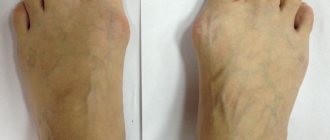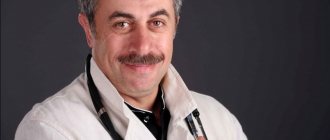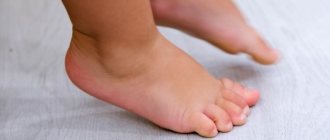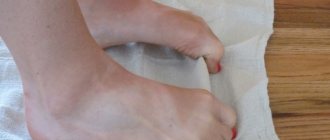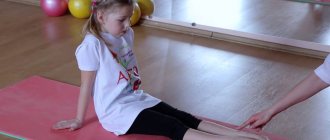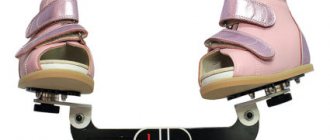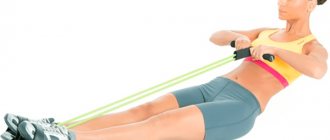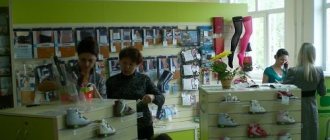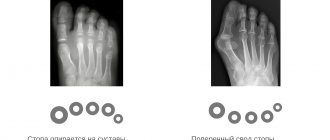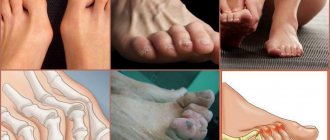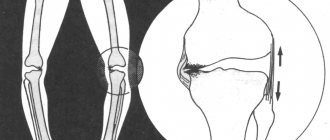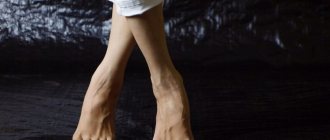Treatment of varus deformity in children is a long and painstaking process, which consists of complex therapy using massage and physical therapy. These two methods have proven themselves to be positive, as they have proven to be effective provided that the techniques for performing the procedures are used correctly. In adult patients, they are used in the postoperative period as part of auxiliary therapy after solving the problem through surgery.
The orthopedist individually selects appropriate exercises for varus deformity, based on the degree of curvature.
Exercise therapy for deformation
Why are exercises necessary?
The bones and muscles of a child’s body are plastic and therefore amenable to mechanical stress. Because of this, the use of physical therapy, especially in the early stages of the disease, helps with varus deformity of the legs. Exercise therapy has a general strengthening effect on the developing child’s body and promotes:
- reducing the radius of varus curvature;
- normalization of muscle tone of the lower extremities;
- complete relief from pathology.
How to do?
A training program carefully selected by an orthopedist to correct deformities of the lower extremities is a guarantee of a positive result. Physiotherapy exercises can be conditionally divided into sets of exercises depending on body position and additional equipment:
In a sitting position, alternate rotation of the feet is performed.
- Sitting position - number of repetitions from 20 times: the feet bend in turn and then straighten;
- the right foot rotates clockwise, after which the left foot rotates counterclockwise;
- The pelvis is placed between the heels - the pose is fixed to a count of 20.
- the foot is pressed tightly to the floor, the person squats using support;
- a “herringbone” pattern is laid out on the floor 1.5 meters long, the foot steps at an angle of 20-30 degrees;
- rolls on the floor from toes to heels and back;
The effectiveness of gymnastic exercises for varus deformity of the lower extremities increases due to the quality of execution. To achieve a sustainable and positive result from physical therapy, it is necessary to adhere to systematic training with an interval of one day - 15 training sessions per month.
Who is suitable for correction of O-shaped curvature of the legs?
To begin with, you should definitely make sure that this deformation is not “false”. False curvature is not a diagnosis. There is no disturbance in the skeletal system. The whole problem is hidden in the muscles. If the curvature is false, it is necessary to train a certain muscle group, or resort to cruroplasty.
If the diagnosis of O-shaped curvature of the legs is confirmed, they resort to surgical treatment of the pathology. Leg correction surgery is performed on both children and adults and is more of a cosmetic treatment.
What will you get as a final result of treatment?
- Beautiful straight legs
- Avoid the onset or progression of complications such as arthrosis deformans;
- Increase your self-esteem
- There will be no post-operative scars on your legs
Massage for children and adults with varus deformity of the legs
What's the use?
Massage procedures help relax cramped muscles and strengthen flabby ones.
Sessions for varus deformity of the tibia cause pain in the child patient, since they are associated with a mechanical effect on not yet formed muscles and bones. At the same time, the procedure shows effectiveness, since during execution the tense muscles relax, and the relaxed ones acquire the necessary tone. The course of treatment includes 15-20 daily sessions with a repetition frequency of 2-4 weeks.
Execution technique
Any massage movement should be carried out very carefully; the risk of injury to the child’s musculoskeletal system is extremely high.
Massage is used as a preventive and therapeutic technique. Depending on the purpose, the procedure is carried out independently or with the help of a qualified specialist. The technique to perform at home for young children consists of 4 exercises:
- While lying on your stomach, bend your leg, then bend your foot, fixing your lower leg.
- To perform this, use a hard surface - in a horizontal position, the shin is pressed against the table, the knee is left straight, the foot is bent and unbent.
- Grab the ankle and gently bend the inner foot towards the outside.
- Rotate your feet clockwise and counterclockwise.
At the end of the session, the feet are massaged.
When a massage therapist conducts a session, he begins by stroking the lower extremities, then proceeds directly to the procedure - massaging each part of the leg in the following sequence:
- thigh - direction of movement from the buttocks to the knees, then in the opposite direction;
- lower leg - massage manipulations pass from top to bottom and back;
- foot is the final stage of the procedure.
During the session, the specialist uses techniques of rubbing, pressure, and vibration on the muscles and bones of the patient’s musculoskeletal system. To obtain results from the procedure, each zone is massaged at least 3 times. The speed of recovery of problem areas depends on the regularity of the procedure.
Massage for flat-valgus feet and flat feet
In case of flat-valgus feet and flat feet, massage is carried out against the background of general strengthening procedures in accordance with the age of the child. Particular attention should be paid to the lumbar spine, where the nerves go to the muscles of the legs and gluteal region. The legs themselves should be massaged using a special technique.
Place your baby on his stomach with his feet hanging over the edge of the table, placing a soft cushion under his shins.
- 1. Back massage: first, stroke along the spine in the direction from the lumbar region to the neck, and then along the side surfaces of the back to the armpits. Rub with your fingertips along the entire back, then knead the back muscles, “saw” them with the ridges of your bent fingers and carry out a final stroking.
- 2. Massage of the lumbosacral region: stroking, rubbing and stroking again in the direction from the spine to the sides and down.
- 3. Buttock area: circular and X-shaped stroking, rubbing with the back of the fingers, kneading and percussive techniques (patting, tapping and chopping). Finish the massage with stroking.
- 4. Back surfaces of the legs: general stroking, stroking the thighs from the popliteal fossae outward and upward, kneading, rubbing, striking techniques (chopping with several fingers, patting) and general stroking again.
- 5. Massage of the back surfaces of the legs is more differentiated, since with a flat-valgus position of the feet, the condition of the muscles can be very different. Start by stroking from the heel to the popliteal dimple. The impact on the calf muscle should be selective: – on the lateral head (outer part of the calf), rub with your fingertips and gently knead. Use relaxation techniques more widely. In addition to stroking, shaking and stretching are recommended; – on the medial head (inner part of the calf), use stimulating techniques: vigorous rubbing with the back of your fingers, deep kneading, as well as percussive techniques – chopping and tapping with your fingers.
- 6. When massaging the feet themselves, the leg should be placed in a supinated position (with the sole inward). First stroke the sole, then rub it vigorously. Also stroke, rub and knead the inner edges of the foot using a tong-like grip. Then the child needs to be turned onto his back, and the cushion placed under his knees. In this position, first stroke the entire leg, and then move on to special techniques.
- 7. Massage the front surface of the thigh using all techniques: stroking, rubbing, gentle kneading, shaking and stroking again. The direction of movement is outward and upward. Stroke the front surface of the shin from the foot to the knee, then rub, knead and stroke again.
- 8. When massaging the ankle joint, use stroking, then rub the muscles around the ankles, using the inner surface of the ankle more vigorously.
- 9. Massage the back of the foot with one hand, while supporting it in a position of slight supination with the other. Techniques include stroking and rubbing with spread fingers. Additionally, you can massage the inner edge of the foot, in particular the area of the big toe.
Massage stabilizes the tone of the muscles of the lower leg and foot, and also relieves excess tension and strengthens weak muscles, which is very important for the coordinated functioning of the muscular system. In addition, it promotes better blood supply to muscles, bones and ligaments, as a result of which their nutrition improves and the growth and development of the legs is normalized. The effectiveness of such procedures will be higher if special exercises are performed against the background of a restorative massage. At the beginning of classes, movements can be passive, that is, performed with the help of an adult.
- 1. Turn the foot inward with the sole (supination of the foot).
- 2. Flexion of the dorsum of the foot.
- 3. Flexion of the sole.
- 4. Finger flexion.
- 5. Supination of the feet with grasping and holding a toy (ball, skittles, etc.).
- 6. Rotation of the feet.
The given exercises must be included in the gymnastics complex. Over time, the baby will master the necessary movements and perform them independently.
Valgus deformity
Valgus deformity of the lower extremities is expressed in an irregular X-shaped appearance of the child's legs. In this case, there is an inward displacement of the middle of the legs.
If there is a distance of more than 4-5 cm between the baby’s ankles in a standing position with the knees clenched, parents are advised to seek help from an orthopedist, who will prescribe effective treatment to eliminate serious problems in the future.
Only a comprehensive effect on the disease can bring benefit. A children's massage therapist will carry out a competent procedure at home , which is one of the most successful and mandatory methods for correcting pathology.
Risk of a problem
Children who have undergone general massage courses before the age of 1 year usually do not have problems with the correct positioning of their legs. Many parents are concerned about the question, how much does baby massage cost ? The procedure is affordable for any family, and the health benefits of your baby from general medical and therapeutic massage are enormous.
Hallux valgus is not always a congenital disease. This may be an acquired defect, which is more common in girls.
The curvature becomes noticeable after several months from the moment the baby stands on his feet and begins to walk.
During this period, the load on the lower limbs increases and, with a weak musculo-ligamentous system, deformation of the legs appears.
Reasons for the development of hallux valgus deformity
The appearance of pathology is caused by changes in the knee joints - a violation of the development of the external condyles. The size of the joint space is larger on the inside than on the outside, which provokes an increase in the load on the inner edge of the foot. As a result, there is a sprain on this side. A characteristic sign is a deformity - a flat-valgus foot.
Reasons causing the development of X-shaped deformation:
- rickets suffered in infancy, especially untreated or occurring in a complex form;
- injuries and diseases of the knee joints;
- deformation of the pelvic ring;
- flat feet;
- thyroid diseases;
- diabetes;
- congenital dislocation of the hip.
Treatment of deformity
To correct hallux valgus in children, the following methods are used:
- gymnastics;
- massage;
- swimming;
- wearing splints for severe forms of curvature;
- physiotherapy;
- elimination of the disease that caused the deformity, for example, rickets;
- wearing special orthopedic shoes and insoles.
Features of massage for hallux valgus pathology
Massage for this type of deformity should be performed by a competent specialist with experience and high qualifications. When carrying out actions, only a professional will determine the areas that require tonic techniques and places where relaxation is necessary.
The purpose of performing a massage for hallux valgus deformity:
- ensuring the distribution of tone in the correct proportions;
- strengthening stretched and weakened leg muscles.
At the preparatory stage, the specialist will examine the child to study the muscle tone on both legs and the peculiarities of the location of the muscles.
Manipulations during the procedure are aimed at generally strengthening the baby’s body with a primary effect on the back, especially the lumbar region, limbs and buttocks.
The buttocks and back benefit from techniques aimed at toning the muscles. It is in these areas of the body that the nerves responsible for the muscle innervation of the legs originate.
On the lower extremities, the use of various techniques depends on the state of muscle tone - their relaxation or tone.
Of great importance for achieving success in treatment is the performance of massage manipulations in the area of the knee joint by a professional who knows how to correctly perform effective adjustments of the knee joint.
The intensity of the massage therapist’s actions increases gradually towards the middle of the course.
At the same time, it is important to perform all techniques without painful sudden movements, so as not to cause a negative attitude towards massage in the baby.
A competent children's massage therapist in Moscow teaches parents the rules of fixing the knee joint using an elastic bandage. This will consolidate and enhance the beneficial effects of gymnastics and massage on the child’s condition.
Complications of hallux valgus
In advanced cases, children experience gait disturbance, uncertainty when walking, rapid fatigue and pain. When one of the legs is bent, the risk of scoliosis, a curvature of the spine, increases to a greater extent.
In the absence of timely treatment of the pathology using painless massage procedures, surgical intervention may be required to solve the problem. This type of elimination of the disease is traumatic, which can negatively affect the mental and physical health of the baby.
Give your child a foot massage. Example.
The boy's parents contacted the Happy Baby children's center when the baby was 1 year and 2 months old. The child has legs like the letter O, so scary to look at. We did a massage course of 10 procedures. The knees were thoroughly massaged. We did a general one. Gymnastics to strengthen the main muscle groups, plus special exercises described above. After working on the knees, the legs were wrapped with an elastic bandage in the area of the knee joints. A soft insert was placed between the ankles (the medial surfaces of the ankle joint). The purpose of bandaging was to stretch the inner edge of the knee joint capsule so that it was more elastic and pliable for straightening the legs. After the first ten massage sessions, parents noted positive dynamics.
After this course, they did not give massages anymore. Mom received recommendations for gymnastics, as well as recommendations from the regional children's clinic. According to the mother, they did primitive exercises: “bicycles,” “raised their legs,” etc., but not for long. The child simply lived a normal schedule. I walked on the street by myself, without support. The legs were slowly, but corrected, under the pressure of gravity, when the legs are positioned wide while walking, the bones and joints of the lower extremities are transformed, it is important to create conditions, to help the body start the process, which is what we tried to do with massage and stretching. Take a look at the before and after correction (treatment) of varus O-shaped deformity of the legs in a child. Overall, this is a credit to the child’s body; we just helped him a little.
Varus deformity
Varus feet in children are the result of diseases such as,
rickets,
long-term inflammatory processes in the area of the bone structures of the legs,
as well as soft tissues (large neoplasms that put pressure on immature bone tissue or grow, violating the anatomical integrity of the tissue).
Injuries of the lower extremities, congenital deformations of the bones of the legs (stigmas of dysembryogenesis or amniotic constrictions in the area of the bones of the lower extremities) are also the basis for the formation of such pathology as varus deformity of the foot.
Crooked legs: does inheritance play a role?
Normally, if you straighten your child's legs, the knee joints and inner ankles should come together. In the presence of an X-shaped curvature, called hallux valgus by doctors, the crooked legs, touching at the knees, diverge downwards.
Many parents consider this deformation to be hereditary and often trigger the problem, making it much more difficult to correct in the future.
However, contrary to popular belief, crooked legs with an X-shaped position are an acquired deformity and not congenital. This deformity is usually a sign of rickets. With this disease, the growth and formation of bone tissue is impaired.
Due to a lack of calcium and its fixation in the bones, which is associated with a deficiency of vitamin D3, rickets leads to softening of the bones and weakening of the muscles, which causes curvature and deformation of the spine, chest, skull, and legs. The baby's legs undergo the greatest changes, because they bear a lot of load when the baby begins to stand and walk. It is during this period that the curvature becomes noticeable.
Since toddlers with X-shaped crooked legs have weakened bones and muscles, in overweight children the curvature may increase due to excess weight - it creates additional stress. Limit your consumption of sweets and starchy foods!
The deformation can also be aggravated by the haste of parents who want to quickly see the first steps of their fidget. Starting to put the baby on his feet before he is ready for this, or often putting him in a walker, fathers and mothers put a lot of strain on the fragile musculoskeletal system. Take your time, give your child the opportunity to gather his strength.
The benefits of physical exercise
Therapy for the treatment of varus deformity necessarily includes massage, daily therapeutic exercises and physical education. Exercise therapy has a positive effect on the youngest patients. Their bone components are elastic and can be easily corrected. The effectiveness of treatment for varus deformity of the tibia directly depends on the prescribed complex and the systematicity of its implementation. A course of physical exercises will allow you to achieve the following results:
- Elimination of pain syndrome.
- Reducing the feeling of discomfort in injured limbs.
- Prevention of the development of disease pathology.
- Prevention of complications and diseases with varus deformity of the legs.
- Increased muscle tone.
- Acquiring the anatomical shape of the foot.
- Normalization of blood flow and provision of oxygen to tissues.
- Removing excess swelling.
- Correction of gait.
Correct crooked legs: the sooner the better
It is almost impossible to get rid of this problem using conservative methods in adulthood. Surgery will be required. Fortunately, with babies everything is simpler, because the child grows and his bones grow.
In order to straighten X-shaped crooked legs, you need to eliminate their main enemy - rickets. Therefore, first of all, children are prescribed procedures to normalize the metabolism of calcium and phosphorus in the body. Usually up to 2.5 years of age, treatment is carried out with vitamin D3.
If by this age the crooked legs do not acquire a normal shape, special plaster casts are used. They stretch the lateral ligaments of the knee joints, which leads to a decrease in the pressure of the femur on the tibia (these bones form the knee joint). As the pressure decreases, the bones begin to grow faster, and the once crooked legs gradually straighten out. This happens as the child grows, so treatment requires a lot of patience - the process usually takes 1.5–2 years.
Additionally, children are prescribed procedures that strengthen muscles: massage, therapeutic exercises, physiotherapy.
In addition, children must wear rigid orthopedic shoes that will securely fix the foot in the correct position.
Varus in a one year old child
While learning to walk, the baby can place his legs in different ways. If they visually resemble the letter “o” in shape, orthopedists use the term “varus.”
What is varus foot placement?
The incorrect position of the legs, especially the feet, in which they are turned inward, is called varus. The term “clubfoot” is often used as a synonym. The latter is more relevant among concerned parents, and has nothing to do with medical terminology.
Not to be confused with clubfoot. This is a medical term denoting a complex pathology that requires intensive treatment from the first weeks of a baby’s life. Varus foot develops during the baby's movements, with active physical activity, in most cases during the period when walking begins - at the end of the first year of life. Often the condition is provoked by other diseases or external factors (for example, previous rickets, premature exercise, etc.). In this case, varus at first glance often looks like a clubfoot.
The legs of a child taking his first steps are flexible, not yet adapted to the weight of his own body. The foot is pliable, not formed. The bones are still made up of cartilage spaced far apart. At one year old, the baby’s ligaments and muscles are very easy to stretch. The formation of the foot will end only by the age of 4, and even then not for all children. Sometimes the process drags on until school age.
Varus deformity is often correlated with flat feet. Little children have flat feet anyway. This doesn't mean it's time to make a diagnosis. The inside of the foot is filled with fat covering the bony layer, giving the appearance of a flat foot. Parents can verify for themselves that there is no pathology. It is enough for a standing baby to stick his finger into the fat layer. If the inner part of the foot has missed 0.5 - 0.8 cm, there is nothing to worry about, flat feet are apparent.
With varus feet, the knees do not touch each other. The foot mainly rests on the outer part; you can stick your hand, or even a ball, into the space formed between the knees. Visually, the feet deviate outward; when trying to take a step, they often overlap each other. Varus deformity is often called O-shaped. Sometimes the thumbs bend strongly inward.
Clubfoot most often affects the entire lower limb: thigh, lower leg, foot. The femur is larger on the outside, the shin curves outward, and the heels tend inward. At the same time, small fingers also often “look” at each other. Varus deformity has several degrees. In severe cases, it is even difficult for young children to fully straighten their legs; when walking, they quickly get tired, their vertical position is unstable, and physical activity decreases.
Signs of varus deformity
Early diagnosis and treatment of varus is very important. The first people who should pay attention to the unusual position of the legs of a standing baby are the parents. If in infancy the deformation may go unnoticed, then when trying to take the first step an adult will most likely notice deviations from the norm.
Signs of varus deformity per year:
- socks look at each other;
- the shape of the legs is O-shaped;
- each foot rests predominantly on the outer area;
- heels “fall over”;
- the baby walks unsteadily, swaying a little;
- It’s hard for a child to walk, he stumbles and gets tired quickly;
At older ages, additional signs appear:
- The knees do not touch each other.
- With prolonged deformation, the child may experience pain in the legs, feet, and knees.
- Such children complain of fatigue; it is difficult for them to run and keep up with their peers.
- Shoes wear out differently: the outer edge of the sole wears out faster.
- It is very difficult to find suitable shoes and boots.
Attentive parents will most likely notice something is wrong when the child first tries to walk. You shouldn’t delay and count on “maybe”; the surest thing is to consult an orthopedic traumatologist.
A slight deformation at first, unfortunately, can lead to even greater curvature of the lower extremities. If the load on the feet is not distributed correctly, the angle of the arch changes. This leads to the “o” shape of the legs characteristic of varus deformity, which, together with unclosed knees, is the first signal in diagnosis.
Cause of varus deformity of children's legs
Kids always move in a way that is easier and more comfortable. This is clearly visible from the child’s crawling manner, and later from the positioning of his legs and walking. If such children continue to have clubfoot after a year, it is not without reason. This position of the feet and the shape of the legs is “dictated” by the existing problem in the development of the baby.
It often happens that a child is examined by specialists who confirm the absence of other diseases, but he continues to turn his feet out when he walks, and his toes curl inward. In this case, the legs are straight in a standing position.
The main causes of varus deformity in healthy babies:
- the child stood on his feet too early;
- different muscle tone;
- heavy weight;
- weakened body after suffering serious illnesses;
- heredity;
- the baby’s body does not absorb calcium and other microelements well;
- incorrect shoes (at an older age);
- traumatic foot injuries.
These reasons are most likely if the baby has no other health problems and is generally healthy and strong.
Particularly active kids strive to explore the world as early as possible. Parents are most often not only proud of such achievements, but also encourage and push their children in every possible way. Orthopedists warn that in most cases this provokes an incorrect position of the legs, their curvature. Doctors strongly recommend not to rush the child to stand on his feet before 8 months, because the muscles are not strong and the tendons are underdeveloped.
A situation less known to parents is when one group of muscles in the lower extremities has increased tone, and the other has decreased tone. In this case, the primary task is to relax, stretch the internal muscles and strengthen the external ones. This problem can occur on one leg or on both legs at the same time.
Excess body weight can cause curvature of fragile bones. It is advisable to put such children on their feet a little later than their peers.
During an examination when varus is detected, experienced orthopedists ask parents whether they, their mothers and fathers, walked with a clubfoot in childhood. It has been established that there is a genetic predisposition to clubfoot. At the same time, it appears exclusively in early childhood, and as it grows up it completely disappears.
A doctor should suspect a problem with the absorption of important micro- and macroelements. There is a special blood test from a vein that will help identify the disorder. Most often in such cases, the absorption of the components alkaline phosphatase (alkaline phosphatase), ca (calcium), 25(on)dz (d3) is checked. Based on the results of the analysis, the child may be prescribed calcium, vitamin D3, etc.
At the same time, if the internal position of the feet is detected, parents should be wary and be sure to visit a pediatrician, orthopedist, or neurologist. In some cases, clubfoot may be the first signal of a serious illness. In such situations, treatment is a necessity, and medical assistance cannot be avoided.
Causes of varus deformity as the first signs of a serious disease:
- metabolic disorders in the body (for example, rickets);
- problems in the endocrine system (diabetes mellitus, thyrotoxicosis);
- diseases of joints, bones;
- pyramidal insufficiency;
- dysplasia.
It is important that diseases such as hip dysplasia have several degrees. If the child has (or has had in the past) a mild form, this could affect the position of the feet when walking upright. At an older age, the joint can be mobile and not cause discomfort only when it bends inward. At the same time, a baby who has suffered mild dysplasia most often noticeably sways from side to side.
After a mild form of rickets, which, by the way, was not necessarily detected in infancy, curvature of the legs is quite likely. In this case, even if you want to, you won’t be able to place your feet straight.
Pyramidal insufficiency may also have been diagnosed in the past. At one year old, most likely, the baby will begin to stand on tiptoes, press his fingers together and bend them inward.
In any case, if the baby is one year old and he still places his legs unevenly, parents should definitely draw the attention of an orthopedist to the existing problem.
Crooked legs: to treat or not?
Despite its apparent harmlessness, X-shaped curvature of the legs is not just a small cosmetic defect. If left untreated, it can cause further problems.
Thus, with rickets, a baby often develops plano-valgus deformity of the feet, since the leg muscles weaken and cannot maintain their normal shape. In this case, an X-shaped curvature can significantly worsen the situation. Due to the incorrect position of the legs, additional stress is placed on the knee and ankle joints, which over time can lead to pain in the legs (usually they appear at high school age), as well as curvature of the spine.
Therefore, like any disease, hallux valgus requires treatment.
Indications for treatment
Parents notice varus deformity in children up to 1 year of age. At this time, the child begins to walk. When walking, the baby shifts its balance to the outer side of the leg. The gait becomes uncertain and painful. Children get tired while playing and complain of pain in their legs and back. By the end of the day, cramping pain in the calf of the limbs is possible. Failure to treat the disease in a timely manner leads to deformation of the hip joint, scoliosis, flat feet, etc. Signs of varus disease:
- The fingers begin to be in a bent position.
- The bones on the foot grow slowly.
- The fingers become hammer-shaped.
- Children complain of pain in the joints of their legs.
- There is frequent fatigue.
- There are difficulties with buying shoes that press on the outside of the foot more than at the base.
How to fix crooked legs: physiotherapy
If, in addition to X-shaped crooked legs, the baby has a flat-valgus foot deformity (very often these problems “come in pairs”), in addition to massage and physical therapy to train weak muscles, the doctor may prescribe a course of electrical stimulation. What is this procedure?
Electrical stimulation occurs using current pulses of varying duration, which causes muscle contractions, improves blood circulation in them, and stimulates their motor activity. During pauses, the muscles relax. The procedure is safe, but it cannot be performed if the baby has a fever, an acute infectious or inflammatory disease, or the skin at the site where the electrodes are applied is irritated or injured.
Text: Yulia Shlykova, consultant - Vyacheslav Kolesov, pediatric orthopedist, Ph.D.
